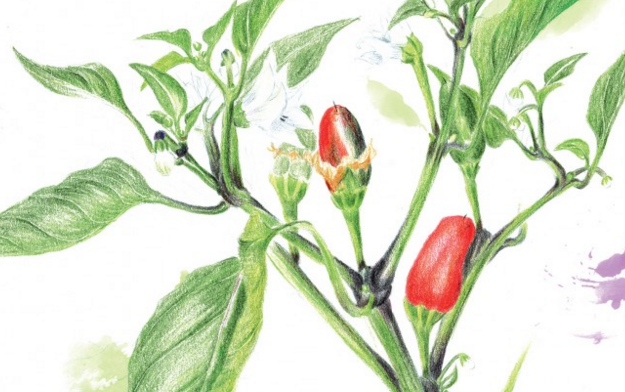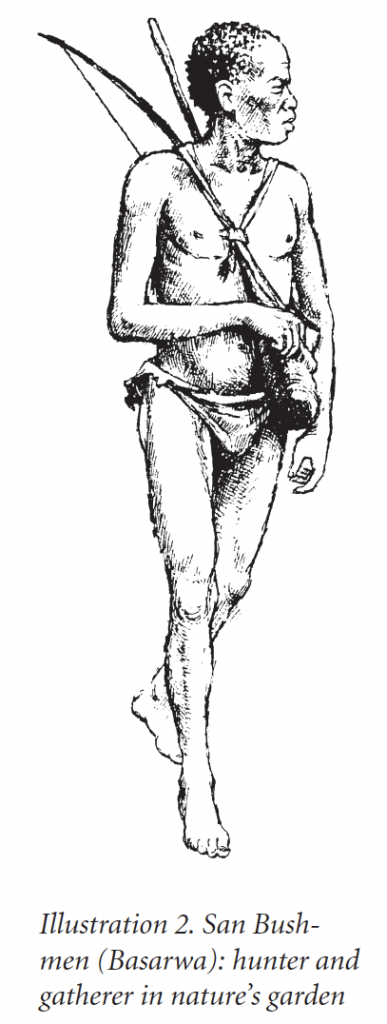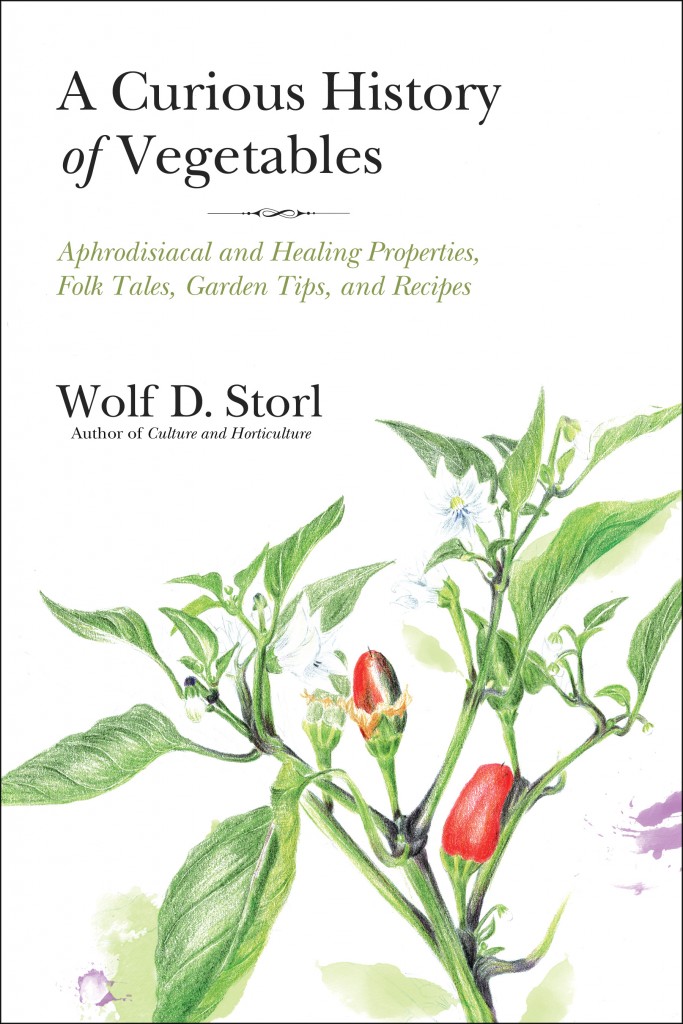The following is excerpted from A Curious History of Vegetables: Aphrodisiacal and Healing Properties, Folk Tales, Garden Tips, and Recipes by Wolf D. Storl, published by North Atlantic Books.
Just as cars need to be fueled, occasionally lubricated, and filled with antifreeze in the winter, the human being has to keep his or her bio machine regularly furnished with the right fuel. Despite general awareness regarding mass-produced “junk food,” some still claim that it does not matter whether the energy sources (carbohydrates and fats), bodybuilders (proteins) and supplements (vitamins and minerals) come from a fast-food hut, a gourmet restaurant, or an expensive natural health food store—claiming that all that matters is that all necessary nutritional building blocks are present in a balanced meal. According to this mechanistic view—which is, incidentally, still taught in the schools—the main nutritional focus is on the basic ingredients. Such a mechanistic view might work very well for machines, but is it an adequate explanation for the function and nature of living organisms?
A fundamental truth is forgotten in the flood of detailed information, in the elaborate charts showing nutritional values expressed in complicated weights and numbers, and in the often contradictory recommendations of experts. That truth: the food that gives life to animals and people consists of plant substance or, more specifically, of the energy of sunlight that plants absorb with the help of light-sensitive chlorophyll. Green leaves can be described as literal “light traps.” The sun’s radiant power enables plants to split the carbon dioxide that animals, microorganisms, and fungi exhale into its constituent elements: oxygen (O2) and carbon (C); and then to combine the carbon with water in order to synthesize it into energy-laden glucose, which is the basis of all organic molecules and the very foundation of all nourishment. By this process an estimated 200 billion tons of biomass are created yearly in the biosphere of our planet.
Aristotle and other ancient Greek philosophers spoke about primal matter as dark, amorphous ur-substance, as Chaos. By contrast, they defined Cosmos as the orderly, formative power of the heavens. When the instreaming cosmic light permeates Chaos, matter is shaped, formed, and harmonized, and becomes animated and alive.
By the above definition we can understand the role vegetation plays in the drama of creation. Plants are intermediaries. They mediate between heavenly Cosmos and material Chaos. They capture the energy of cosmic light, and use it to vitalize, inform, and animate raw, “nonliving” earthly matter consisting of the primordial elements fire, air, water, and earth. These vitalized elements, in turn, can serve as nourishment for all other living beings. (The harmonizing structuring influence of sunlight on living things can be seen, for example, when we observe how potatoes sprout in dark cellars: pale, deformed, and without direction, they twine about until they happen upon a beam of light coming through a crack; then suddenly the sprouts turn green, straighten up, and begin to grow in an orderly way.)
The moon and the planets also impart structuring impulses. When we eat grains, fruits, and vegetables that have grown in a natural way, i.e., in organic soil and natural sunlight, the structuring photonic energy is also transmitted to our bodies, which, in turn, affects our thoughts and feelings. Obviously, our inner world is not separated from our physical bodies; we are what we eat.
This wonderful process, which science calls photosynthesis, was interpreted in ancient India as a form of meditation: plant entities find themselves in a state of samadhi, the blissful state of deepest meditation and oneness with divine origin. Motionless, silent, and rooted in the earth, they surrender themselves completely to the sky and absorb with their green foliage the light that shines down from the sun, moon, and stars. They are thus in a constant state of divine and eternal harmony. According to the Upanishads, plants consume cosmic and stellar energies and, in turn, offer themselves for others to eat. “The creatures that live on the earth come into being through food; they live through food and finally they merge into food” (Anandavalli Upanishad). Whenever humans beings or animals satisfy their hunger with fruits, roots, leaves, stems, or seeds of a plant, quanta of cosmic light and warmth are converted not just into body warmth, but also into the warmth of feelings, the heat of passion, and at last the inward light of consciousness.
Ultimately, the Rishis and seers in old India interpreted the cosmic light that plants absorb as the shining light of divine love: “Brahma is food. Only he who realizes that he is eating God, truly eats” (Taittireya Upanishad). This cosmic light that the plants are constantly meditating on was also perceived as om, the primordial, all-pervasive sound emanating from the sun. This primordial light and sound divides, splits, and shatters into countless vibrations—which constitute cosmic harmony. According to these ancient seers, in each vibration a godly being, a deva (the spiritual entity that expresses itself in the plant),1 or angel, incarnates. In the vision of the seers, cosmic beings can enter the material world in the form of plants. Each kind of plant, each species, is a manifestation of a deva. When people prepare certain plants as meals, healing mixtures, or psychedelics, they make it possible for a certain deva to temporarily leave the macrocosm (external nature) and enter the human or animal microcosm. There it can unfold its properties. In the human microcosm these “angels” and “gods” manifest in various nuances as good health, moods, dreams, thoughts, intuition, and inspiration.
According to this old Vedic belief, even the spirits of the ancestors who wish to reincarnate on earth find their way from the beyond through the vegetables and grains eaten by the man and woman who will beget them. If things are really as the ancient Rishis claim, then it is not surprising how carefully most traditional peoples cultivate and prepare their food. It is not just a matter of assembling the necessary material nutrients: it is a matter of religion, of bonding with the gods, the ancestors, even with the godly Self. The Ayurvedic nutritional doctrine distinguishes three different characteristics (gunas) of nourishment, as follows:
- Sattva: foods that are pure and full of cosmic light and also feed the soul with cosmic harmony. Such foods grow in wild nature or are cultivated in an organic vegetable garden. Honey, milk, and dairy products—from naturally held, healthy cows (cows that are free to enjoy sunlight and green pastures, and have not been maltreated with hormones and antibiotics, or had their horns removed)—also belong to this category. It is the proper food of those who meditate and live a quiet life.
- Rajas: foods that further an active life, providing strength and energy. Meat and strong spices fall into this category. It is the nourishment of energetic and active people, including warriors and athletes. Onions, garlic, peppers, and tomatoes are all considered rajasic.
- Tamas: foods that make the body sluggish and the spirit dull. For example, meat from animals that have not been well cared for and are terrified when slaughtered is considered tamasic (to the extreme). Also, vegetables raised under artificial lights and with the help of herbicides and pesticides are tamasic. These are the foodstuffs that sustain the low side of our nature—or even the demonic side. Most assuredly genetically “improved” foods fit into this category as well, since the cosmic influence has been interrupted and chaoticized; such degraded food can only communicate noncosmic information to our bodies.
To a large degree we have the freedom to choose what we eat and which influences we avail ourselves of. It is in our hands to determine whether angels (devas) or demons (rakshasas) enter our microcosm. Correctly understood, the food we eat has karma in store for us. With satvic food (i.e., pure and wholesome), we advance our spiritual development; with tamasic food (i.e., old, foul, or unpalatable), we do just the opposite: we promote pessimism, ignorance, laziness, criminal tendencies, and doubt.
Such insights are not unique to Asian cultures, however. There have often enough been voices in Western cultures that verify such maxims. “Show me what you eat, and I will tell you who you are,” said the French novelist and gastronomist, Jean Anthelme Brillat-Savarin (1755–1826). In Shakespeare’s Julius Caesar Cassius asks, regarding Caesar, “Now, in the name of all the gods at once, upon what meat does this our Caesar feed that he is grown so great?” In a lecture a few years ago, the Dutch artist and botanist Herman de Vries listed all the plants to whom he owes his personality and being. The lecture, consisting of nothing but plant names—from apple to zucchini—lasted a couple hours. He concluded, “These are the plants that I have eaten and that have made me who I am today.” And Rudolf Steiner, the founder of anthroposophy, once said, “We not only eat that which we see before our physical eyes, but we also eat the spiritual essence, which is hidden behind the physical manifestation.”
Each plant species, thus, has its own characteristic vibrations that are transmitted to the person who eats them. The elements, the soil, the water, and especially the sun are the basis of these vibrations. The formative forces are obvious: some plants prefer shade, others prefer direct sunlight; some like cool temperatures and others prefer the heat; some open their blossoms early in the morning, others late in the afternoon, and even some wait until after sunset.
We know that the sun has different qualities and effects depending on the time of year or the sign it is in. When it is in Scorpio, Sagittarius, or Capricorn, it is less powerful than when it is in Gemini, Cancer, or Leo. So called “short-day” plants—such as rice, millet, cotton, dahlia, Jerusalem artichoke, chrysanthemum, or soybean—blossom when the sun reaches Virgo and the days start to grow shorter than the nights. Long-day plants—such as carrots, cabbage, fava beans, beets, spinach, or lettuces—need, by contrast, more than twelve hours of sun each day in order to be able to blossom. For this reason, they never reach the blossom stage in the tropics.
Though most plants flower in the summer and bear fruit in the fall, some plants show curious shifts. Food plants, especially grains and fruits, are in harmonious unison with the yearly sun cycle and therefore have a harmonious and energizing effect on us. Plants that blossom in fall and winter, such as autumn crocus and helleborne, have fallen out of the cosmic rhythm—so much so they often prove to have a poisonous, destructive effect on our body rhythms. Under certain circumstances, however, these kinds of plants can be used medicinally, such as to bring on a severe somatic reaction.
The daily cycle is also important for plants. The light spectrum varies with the movement of the sun across the sky. Thus, its effect on the vegetation is different in the early morning hours than it is at other times of day. Plants go into sleep or wake positions, and flowers open or close their buds, or emanate their fragrance or not—all depending on the position of the sun. Traditional herb gatherers and gardeners know this and harvest accordingly. Swedish botanist Carl Linnaeus (1707–1778) planted a floral clock in his garden in Uppsala that was based on this principal; he could tell the exact time of day with it. Similarly there are also “fragrance clocks.”
Vegetation is also influenced by its location, especially in terms of its longitude and latitude and the angle of the sunrays hitting it. German poet and plant enthusiast Johann Wolfgang von Goethe (1749–1832) recognized this on his extensive trip to Italy in the late eighteenth century, where he noted that familiar plants growing there looked very different from those in his homeland. More subtle influences are also at work in plant expression, such as conjunctions, oppositions, trigons (triangle constellations), and the position of the moon and the other planets. Indeed, alchemists and medieval doctors drew up entire plant taxonomies on the basis of planetary signatures. By keenly observing the physiognomy of the plants, they recognized which planetary forces—or even which planetary gods—were at work in the respective plant. According to this classification, for example, the red beet was described as belonging to Mars, with a tinge of Jupiter and Saturn involved. The swallowwort or greater celandine, which contains yellow juice that tastes like bile, was ascribed to Jupiter, whose organ is the liver. The sedative effect of this juice was attributed to a slight lunar (Moon) influence. Herbs rich in mucilage, like the mallow or comfrey (Symphytum), belonged to Mercury, though, as a bone healer, comfrey was also associated with Saturn. All told, what to us may seem to be a mere expression of superstition was in fact once a useful astrological system of plant classification, one that unfortunately has not survived to today.
Notes
- From Sanskrit, etymologically related to the Latin divus = godly; old Latin deivos = God; Celtic devos = a god. A deva is, thus, a heavenly being of light.
From A Curious History of Vegetables by Wolf D. Storl. Published by North Atlantic Books, copyright © 2016 by Wolf D. Storl. Reprinted with permission of publisher.














